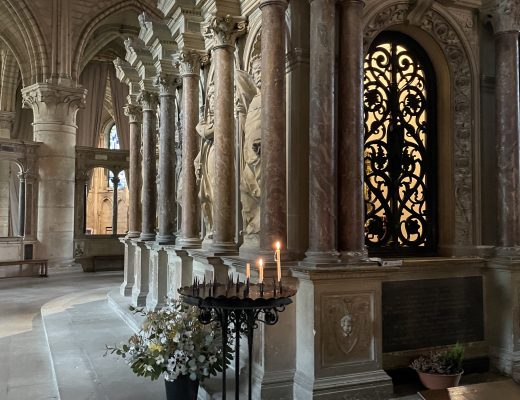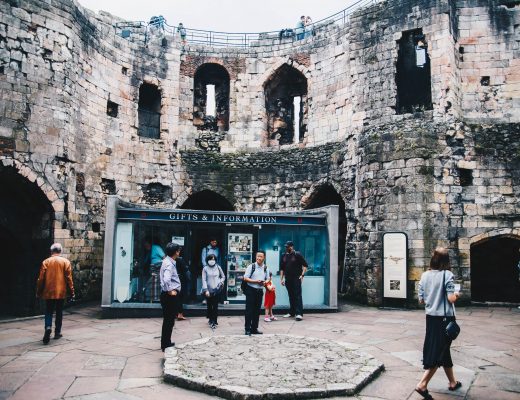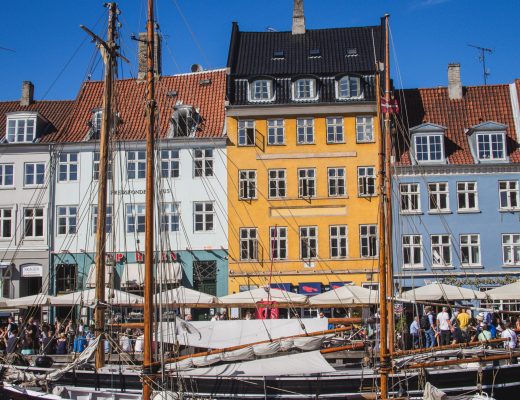When I registered at the library (which was literally one of the first things I did when we moved to York), I was given the option to get a regular card or pay £5 for a York Card. I opted for the York Card, which gets you in free to the Minster and gives you a discount to all the other museums and tourist attractions. Since I’ve been to the Minster twice now, I’ve already made my money back.
York Minster is the second largest Gothic cathedral in Northern Europe, which is a pretty awesome claim to fame. The most recent incarnation of the Minster was started in 1230 and completed in 1437. It’s really the second Minster that has stood on that particular spot as it was built over the Norman one. (And that was built over some of the Roman city.) Because it’s a living church and not just a historical monument, you’ll need to time your visits around services and events (unless you want to take part, which the Minster more than welcomes you to!)
Pretty cool facts about York Minster:
- York Minster holds 60% of England’s medieval stained glass.
- The Central Tower is large enough to fit the Tower of Pisa inside.
- The Chapter House hosted Edward I’s parliament in 1297.
- The Central Tower collapsed once in 1407 and nearly did again in the 1970s.
- It was one of the first Cathedrals to introduce girl choristers into the mix.
Slightly unsurprisingly to people who know me well, I’m a bit of an obscure history nerd. And by a bit, I mean, I’m a hardcore history nerd and I’d never believe if you’ve seen one church you’ve seen them all. (And saying museums are boring is as close to sacrilege as you can get with me.)
The point of that introduction is to explain one of the reasons I was really excited to look around the Minster in depth: I was really hoping that there would be some kind of plaque or marker pointing out where Tostig Godwinson was buried originally. (Spoiler: there wasn’t).
Who is this crazily named man you might wonder? He was the brother to the last crowned “English” (i.e. Anglo-Saxon) King of England. He was killed at the Battle of Stamford Bridge, having convinced Harold Hadrada of Norway to invade and help defeat his brother, King Harold Godwinson. Even after Hadrada, King Harold was getting zero peace. He lost in the end, pretty famously to William the Conqueror. Laters Anglo-Saxons, hello Norman rule.
If you read back on some of my old posts, you might even see me re-enacting King Harold’s death at Battle Abbey because I’m a weirdo.








*I’m pretty sure I was telling Sam a story about an English king (I just talk a lot with my hands). So here I am in full-on nerding out!*














Playing in the children’s dress up box.




But you don’t have to be a massive dork like me to enjoy the Minster. It’s steeped in history. It’s stunning. (And if literature is more your thing, you can pretend you’re in “Jonathan Strange & Mr Norrell” and picture all the statues coming to life.)
Now a complaint I’ve heard from people is “Why do I have to pay to go into York Minster? Why isn’t it free to go into a church? Doesn’t the Church pay for everything?” The Minster costs about £20,000 a day to keep it open. First, the Minster receives no state funding. Second, if you are there to pray or attend service, or even just to light a candle, you don’t have to pay. Third, the Church of England argues that it can’t take on the sole burden of financial upkeep themselves through the coffers. And you know what? I buy that. Museums in England are largely free because they are cross-funded. Without an entry fee, and with the sheer number of tourist visitors and corresponding upkeep, the only other option would be to close the site to worshippers only. Cathedrals are an extremely important part of the heritage of Northern Europe, and in a debate of heritage vs tourism, I’ll side with whatever keeps them standing and open to everyone.
Adults pay £10, children are free. Tickets are valid for multiple entry for the entirety of that year. Entrance is also free to residents of York with their York Cards. It’s open for sight-seeing from 9-5pm.




